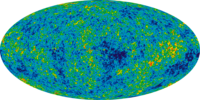Comoving distance

Have you ever heard the phrase "distance is relative"? Well, comoving distance takes that phrase to a whole other level.
Let's start with the basics. When we measure distance between two objects, we usually just measure how far apart they are in physical space, like how many miles or kilometers there are between them. But in space, things are a little more complicated because space itself is "expanding".
This means that over time, objects in the universe are moving away from each other. So if we measure the distance between two objects, we have to take into account that the distance is changing because space itself is growing.
That's where comoving distance comes in. It's a way to measure the distance between objects in space while taking into account the expansion of the universe. It's like measuring how far apart two people are on a moving sidewalk - the distance between them is changing because the sidewalk is moving, but if we walk at the same pace as the sidewalk, we can measure the distance between us without it changing.
To calculate comoving distance, we use a mathematical formula that takes into account the expansion of the universe. Essentially, we imagine that we're standing still and the rest of the universe is moving away from us. By doing this, we can calculate how far away something is from us now, even if it was much closer in the past.
So, let's say we're looking at a galaxy that's 10 billion light years away. That means that the light we're seeing from the galaxy took 10 billion years to reach us. But because the universe has been expanding during that time, the galaxy is now much farther away than it was when the light was emitted. To calculate the comoving distance, we use a formula that takes into account the expansion of the universe over that 10 billion years.
Comoving distance is important for astronomers because it allows us to accurately compare the distances between objects in space, even if they're at different points in time. It's a little confusing, but just remember that comoving distance is like measuring how far someone is on a moving sidewalk - it takes into account the movement of space itself so we can accurately measure how far apart objects are.
Let's start with the basics. When we measure distance between two objects, we usually just measure how far apart they are in physical space, like how many miles or kilometers there are between them. But in space, things are a little more complicated because space itself is "expanding".
This means that over time, objects in the universe are moving away from each other. So if we measure the distance between two objects, we have to take into account that the distance is changing because space itself is growing.
That's where comoving distance comes in. It's a way to measure the distance between objects in space while taking into account the expansion of the universe. It's like measuring how far apart two people are on a moving sidewalk - the distance between them is changing because the sidewalk is moving, but if we walk at the same pace as the sidewalk, we can measure the distance between us without it changing.
To calculate comoving distance, we use a mathematical formula that takes into account the expansion of the universe. Essentially, we imagine that we're standing still and the rest of the universe is moving away from us. By doing this, we can calculate how far away something is from us now, even if it was much closer in the past.
So, let's say we're looking at a galaxy that's 10 billion light years away. That means that the light we're seeing from the galaxy took 10 billion years to reach us. But because the universe has been expanding during that time, the galaxy is now much farther away than it was when the light was emitted. To calculate the comoving distance, we use a formula that takes into account the expansion of the universe over that 10 billion years.
Comoving distance is important for astronomers because it allows us to accurately compare the distances between objects in space, even if they're at different points in time. It's a little confusing, but just remember that comoving distance is like measuring how far someone is on a moving sidewalk - it takes into account the movement of space itself so we can accurately measure how far apart objects are.
Related topics others have asked about:
